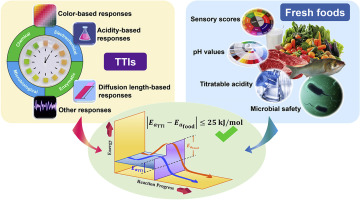Trends in Food Science & Technology ( IF 15.1 ) Pub Date : 2020-03-03 , DOI: 10.1016/j.tifs.2020.02.019 Tingting Gao , You Tian , Zhiwei Zhu , Da-Wen Sun

|
Background
Real-time temperature monitoring during cold chain logistics is critical because refrigerated foods are sensitive to temperature fluctuations. Time-temperature indicators (TTIs) are effective tools for monitoring the temperature history of food products in real-time. These technologies have been widely used in fresh food management, showing great potential to reduce food waste, ensure food safety, and achieve realistic control of the cold chain and cold storage of foods.
Scope and approach
This review presents commonly used modelling methods for TTIs establishment, including reaction rate constant (k) and activation energy (Ea) determination and Ea matching. Through mathematical modelling, shelf-life of TTIs can be matched with shelf-life of target foods, making response changes of TTIs reflect food quality. For the first time, different apparent response types of TTIs are summarized, covering colour-based, acidity-based, diffusion length-based, and other responses-based TTIs. Besides, TTIs applications in cold chain management of fresh foods are also highlighted concerning dairy, meat and aquatic products, and vegetables.
Key findings and conclusions
TTIs are effective temperature-sensitive monitoring tools and have been studied for monitoring various refrigerated fresh food products, especially for meat and aquatic products. Arrhenius equation is the most widely used mathematical modelling for matching kinetics of the food products and the TTI responses. Colour-based responses increasingly become the most popular response types of TTIs for the advantages of convenient and direct observation. The future trends of TTIs development should mainly focus on the integration of multiple quality indicators, constituent simplification, cost reduction, and modelling optimization.
中文翻译:

时间-温度指标(TTI)在监测新鲜食品质量中的建模,响应和应用
背景
由于冷藏食品对温度波动敏感,因此在冷链物流中进行实时温度监控至关重要。时间温度指示器(TTI)是实时监控食品温度历史记录的有效工具。这些技术已广泛用于新鲜食品管理中,显示出减少食品浪费,确保食品安全并实现对食品冷链和冷藏的切实控制的巨大潜力。
范围和方法
这篇综述介绍了建立TTI的常用建模方法,包括反应速率常数(k)和活化能(E a)的确定以及E a的匹配。通过数学建模,可将TTI的货架期与目标食品的货架期相匹配,从而使TTI的响应变化反映出食品质量。首次总结了不同的TTI表观响应类型,涵盖了基于颜色,基于酸度,基于扩散长度和其他基于响应的TTI。此外,还着重介绍了TTI在新鲜食品冷链管理中的应用,涉及乳制品,肉类和水产品以及蔬菜。
主要发现和结论
TTI是对温度敏感的有效监视工具,并已进行了研究,以监视各种冷藏的新鲜食品,尤其是肉类和水产品。Arrhenius方程是用于使食品动力学和TTI响应相匹配的最广泛使用的数学模型。基于颜色的响应越来越多的便捷,直接观察的优势逐渐成为TTI最受欢迎的响应类型。TTIs发展的未来趋势应主要集中在整合多个质量指标,简化组件,降低成本和优化模型上。











































 京公网安备 11010802027423号
京公网安备 11010802027423号